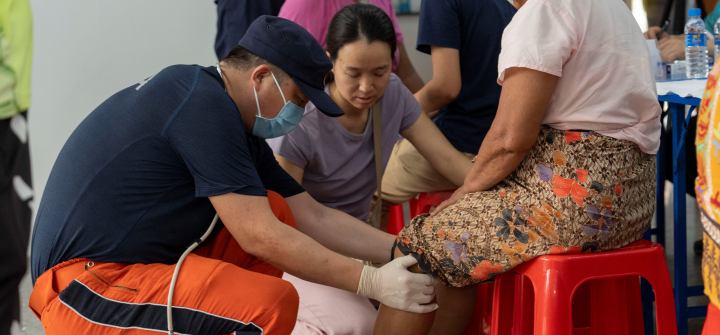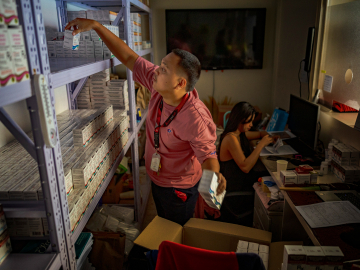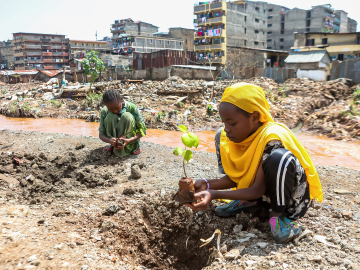Rehabilitation: The Frontline We Keep Forgetting
Natural disasters don’t just break bones, they break lives.
On March 28, 2025, lives changed in a matter of seconds when an earthquake measuring 7.7–7.9 trembled across the Sagaing region, in Burma (Myanmar), the deadliest seismic event since the 2023 Turkey-Syria disaster. The initial death toll on March 29 was 1,600—with 3,408 injured—but by July 2, the numbers had climbed to 3,768 fatalities and 5,104 injuries.
As emergency medical teams (EMTs) rushed in to provide urgent care, perform surgeries, suture wounds, and save lives, one vital component was largely absent on the frontlines: rehabilitation.
For many survivors, the real challenge begins after surgery. A mother who has lost a limb, a child with multiple fractures, an elderly man with a spinal cord injury—all may survive the disaster, but without the aid of early rehabilitation, they face a greater risk of long-term disability, pain, and, critically, the loss of independence.
Rehabilitation is one of the most overlooked elements of disaster response. Even after years of global advocacy and guidance, early rehab is still seen as optional or secondary and is systemically excluded from emergency response plans. Yet rehabilitation is not a luxury, it is a lifeline. It is as essential as the first surgical cut or an intial dose of antibiotics.
Physiotherapists help patients regain their strength, relearn movements, manage pain, and restore basic functions like walking, breathing, or even sitting upright to eat. In disaster zones, early rehabilitation can mean the difference between healing and lifelong hardship.
This issue is not new. Following the April 2013 Ya’an earthquake in China, two Chinese doctors who specialize in rehabilitation medicine, Sasha Li and Chengqi He, called on rehabilitation professionals worldwide to advocate for their own timely deployment—not post-crisis, but alongside the initial medical response. The call was clear then, as it is now, that early rehab must be embedded in emergency care—not follow behind it.
International guidelines call for rehabilitation to be part of the emergency response, including a global handbook, Early Rehabilitation in Conflicts and Disasters, developed by the WHO and the World Confederation for Physical Therapy in 2016. It emphasizes that rehabilitation should begin in the earliest stages of emergency responses, not weeks or months later, but ideally within the first few days after a disaster once patients are medically stable. This explains how physiotherapists can help prevent life-altering complications like pneumonia, pressure injuries, and joint contractures through early movement, respiratory care, and proper positioning.
These are not optional extras; they are medically proven, evidence-based interventions. And yet, delivery of rehabilitation services during emergencies is inconsistent, often due to lack of planning, resources, and awareness. Ghasem Mousavi, a specialist in rehabilitation needs in disaster settings, focused mainly on Iran, and his team detailed these shortcomings in a 2019 systematic review.
Combing through situation reports of the response to the earthquake in Burma, I could not find any public indication that physiotherapists were deployed as part of the first response. The International Medical Corps, who clarified that their emergency services focused only on acute care and did not include physical therapy.
In contrast, in countries including the U.K. and Canada, physiotherapists are ready to deploy during natural or manmade crises; they have embedded rehabilitation into their EMTs. They are trained to work under pressure, adapt in the challenging environments, and provide patient-centered care from day one.
Real-world examples support this integration. After the 2020 Beirut Port blast, the International Committee of the Red Cross deployed rehabilitation professionals within weeks, resulting in significantly improved patient outcomes. Physiotherapy interventions were promptly initiated mostly within 24–72 hours post-injury for patients who were medically stable and included range of motion and strengthening exercises, gait and balance training, functional activities (e.g., self-care tasks, walking short distances, stair climbing, etc.), and for some, assistive devices all aimed at restoring independence. More recently, following the August 2025 earthquake in Afghanistan, NGOs such as the Norwegian Afghanistan Committee deployed rehabilitation teams within days of the disaster, offering physiotherapy, orthopedic care and mobility aids alongside acute care—representing an encouraging step towards integrating physiotherapy earlier into emergency response.
To continue to advance rehabilitation efforts in emergency settings, health care systems must move beyond policy and into action. Governments and humanitarian agencies must prioritize training more physiotherapists to respond in emergencies following published guidelines. EMTs should include rehabilitation professionals as standard, not as an afterthought, and work together to minimize casualties. It is not just about recovery; it is about giving people back their lives with function.
Rehabilitation must not be delayed. It must begin where the emergency begins.
Emaan Zahra Ijaz, BPT, is a fourth-year physiotherapy student at Gulf Medical University, UAE, with a growing interest in rehabilitation in global health and emergency settings, and the author of two published books.
Join the 50,000+ subscribers in 170+ countries who rely on Global Health NOW summaries and exclusive articles for the latest public health news. Sign up for our free weekday newsletter, and please share the link with friends and colleagues.
A member of China Search and Rescue Team provides medical consultations for local residents in Mandalay, Myanmar, April 5, 2025. Image: Cai Yang/Xinhua via Getty





